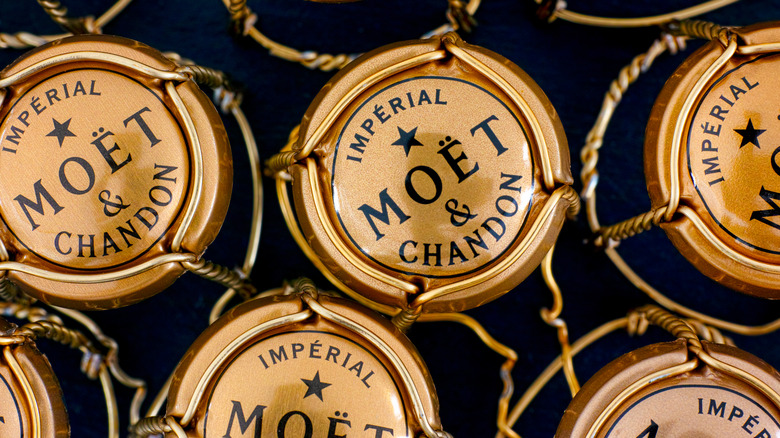The Most Bizarre Ingredient Was Found In Bottles Of Champagne
While "Emily in Paris" might enthusiastically spray a bottle of Champére around the club (via Vine Pair), another French champagne has a seriously unwanted pop in some of its bottles. Although champagne can bring a celebratory mood, some bottles of Moet & Chandon are being poured down the drain for very good reason. According to a recent Newsweek report, certain lots of the brand's alcohol are being recalled for contamination. Specifically, there was MDMA, or ecstasy, introduced into the luxury three-liter XXL Ice Imperial bottles of Moet & Chandon champagne.
While these particular bottles were found in Germany, Luxembourg, and the Netherlands, the issue is not an isolated one. According to Food and Wine, a similar contamination occurred in February. Previously, the altered beverage caused multiple illnesses and a death. Those reports state that the infected champagne can be detected once the bottle is opened. From not having its signature sparkle to an anise odor, there are elements that distinguish the impacted wine. As the particular lots are pulled, drinkers are encouraged to examine their drinks before it touches their lips. It might not be a dangerous kiss from the comic book villain Poison Ivy, but this spiked beverage could be lethal.
How can you tell if your champagne has been tampered with?
Popping open a champagne bottle usually denotes a celebration. Whether it is a production with sabering a bottle or simply twisting the cork, the golden liquid with its sparkling bubbles brings the party. With the recent reports of some Moet & Chandon magnums being contaminated with drugs (via Delish), people are raising the question of how to tell if the bottle has an unwanted fizz.
The concept of altering the liquid in a wine bottle is not necessarily new. Unlike Rudy Kurniawan's legendary schemes of duping wine collectors with fake vintages, this wine replacement does far greater harm than drinking poorly fermented grape juice. According to Food Safety News, these particular Moet & Chandon champagne bottles did not visually appear like the traditional beverage. It lacked its effervescence, noting no bubbles. While that characteristic might not instantly be apparent, the different smell and unusual color were additional factors suggesting that the champagne was off. Although the story of drinks being spiked might not be a new conversation, this situation is a reminder for people to be aware of their beverages. Appearance, smell, and taste can be indicators that something is amiss. It might not be a litmus test or color-changing nail polish, but the senses can be a line of defense to avoid drinking an unwanted additive in that beverage.

